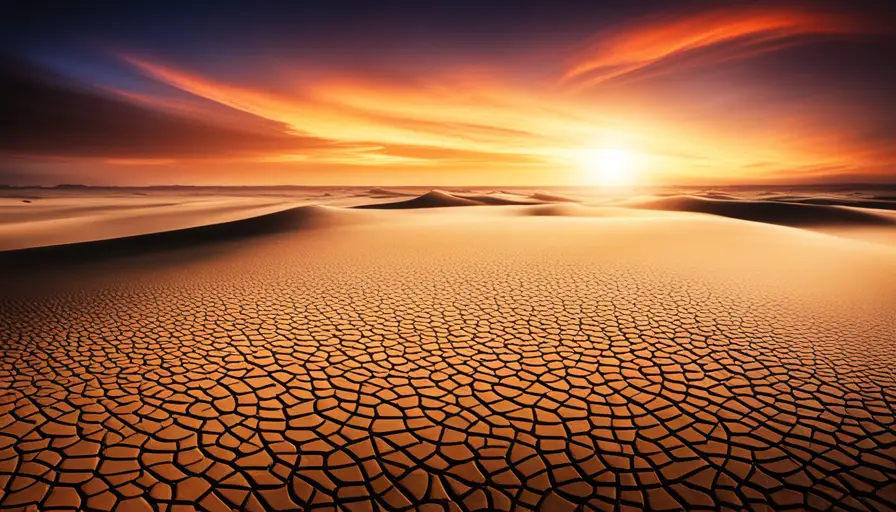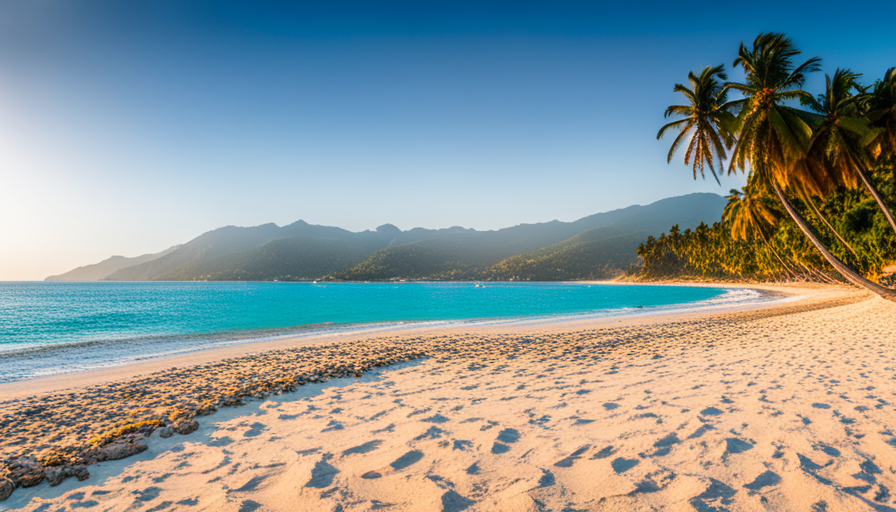Picture yourself lying on a beach, feeling the warm sand beneath you and the cool ocean breeze on your skin. The sun is shining brightly above, and you can hear the gentle crashing of waves in the distance. It’s the perfect day for a beach getaway, but have you ever wondered how the climate at your favorite low humidity beach affects your experience?
In this comprehensive study, we aim to unravel the mysteries of low humidity beach climates and provide you with a deeper understanding of the unique weather conditions that shape your beach vacation. From the impact of low humidity on temperature to the intricate wind patterns that characterize these coastal havens, we will explore the factors that influence weather conditions in these areas.
But why should you care about understanding the climate at low humidity beaches? Well, knowing the differences between low humidity and high humidity beach climates can help you make informed decisions about where to plan your next seaside escape. Additionally, we will uncover the benefits of low humidity for beachgoers, as well as provide you with practical tips for enjoying a day at a low humidity beach.
So join us on this scientific journey as we delve into the fascinating world of low humidity beach climates. Together, we will unlock the secrets of these coastal paradises and empower you with the knowledge to fully embrace the freedom and serenity they offer.
Key Takeaways
- Low humidity beach climates have significant impacts on temperature, soil moisture, wind erosion, and flora/fauna adaptations.
- Understanding the differences between low humidity and high humidity beach climates is crucial.
- Low humidity provides a more enjoyable experience for beachgoers and promotes outdoor activities.
– Future research in climate science focuses on modeling, carbon capture, renewable energy, adaptation strategies, and policy/governance evaluation.
The Impact of Low Humidity on Temperature

The impact of low humidity on temperature can be felt more intensely in coastal areas, where the combination of dry air and cool ocean breezes creates a unique microclimate. Understanding the effects of low humidity on temperature is crucial in assessing the impact of climate change on coastal ecosystems.
Low humidity exacerbates the effects of high temperatures in coastal areas. As the air becomes drier, it loses its ability to retain heat, leading to rapid temperature fluctuations. This can have significant consequences for both terrestrial and marine ecosystems.
For instance, increased temperatures can accelerate the melting of glaciers and ice caps, leading to rising sea levels. This poses a threat to coastal habitats and can result in the loss of critical biodiversity.
Furthermore, low humidity affects the moisture content of the soil, impacting plant growth and agricultural productivity. As moisture evaporates quickly in dry conditions, the soil becomes less fertile, making it challenging for plants to absorb nutrients and water. This can disrupt the delicate balance of coastal ecosystems and lead to the loss of important flora and fauna.
To mitigate the impact of low humidity on temperature, it is essential to implement sustainable practices that reduce greenhouse gas emissions and promote climate resilience. This includes conserving water resources, implementing efficient irrigation systems, and adopting climate-smart agricultural techniques.
By understanding the relationship between low humidity and temperature, we can better protect and preserve coastal ecosystems for future generations.
Wind Patterns at Low Humidity Beaches

Contrary to popular belief, wind patterns greatly influence the unique environment found at beaches with low humidity. The interaction between wind and the landscape plays a significant role in shaping the features and characteristics of these beaches.
One of the key effects of wind at low humidity beaches is wind erosion, which occurs when the force of the wind removes loose particles from the surface. This erosion process leads to the formation of sand dunes, a defining feature of these beaches.
The prevailing wind direction is an important factor in determining the shape and size of the sand dunes. Wind blowing parallel to the coastline creates long, linear dunes, while wind blowing perpendicular to the coastline leads to crescent-shaped dunes known as barchans. The height and stability of the dunes also depend on the wind strength and frequency. Strong winds can result in taller dunes, while frequent wind events can cause the dunes to become more stable and resistant to erosion.
Understanding the wind patterns at low humidity beaches is crucial for preserving these delicate ecosystems. By studying the wind erosion processes and the formation of sand dunes, scientists can develop strategies to mitigate the impacts of wind on these beaches. This knowledge can also aid in the conservation efforts aimed at protecting the unique flora and fauna that thrive in this challenging environment.
So, next time you visit a low humidity beach, take a moment to appreciate the fascinating role that wind plays in shaping its landscape.
Factors Influencing Weather Conditions

When you step onto the sand, you’ll feel the weather’s embrace, influenced by a symphony of factors. Understanding the factors that influence weather conditions at low humidity beaches is crucial for comprehending the climate in these unique environments.
Several key factors play a role in shaping the weather patterns experienced at these beaches. Air Pressure: Variations in air pressure can significantly impact weather conditions. High-pressure systems often bring clear skies and dry weather, while low-pressure systems are associated with stormy conditions and increased precipitation.
Wind Patterns: The direction and speed of winds can affect the temperature and humidity levels at low humidity beaches. Prevailing winds can carry moisture, influencing the overall weather patterns experienced.
Geographic Location: The location of a beach relative to nearby bodies of water, mountains, or other geographical features can greatly influence weather conditions. Proximity to large bodies of water can increase humidity levels, while mountains can create local weather patterns.
Topography: The shape and elevation of the land also play a role in determining weather conditions. Steep slopes can cause air to rise and cool, leading to cloud formation and potentially precipitation.
Vegetation: The presence or absence of vegetation can impact weather conditions. In low humidity environments, the lack of vegetation can result in increased evaporation and reduced moisture levels in the air.
The effects of low humidity on flora and fauna at these beaches are significant. The limited moisture availability can result in adaptations among plants and animals, such as increased water efficiency and specialized mechanisms for surviving in arid conditions.
Understanding the interplay between these factors is crucial for gaining a comprehensive understanding of the weather conditions at low humidity beaches.
Differences Between Low Humidity and High Humidity Beach Climates

As you step onto the sand, you’ll notice a striking difference between low humidity and high humidity beach climates. Low humidity beaches have significantly less moisture in the air compared to high humidity beaches, resulting in distinct microclimates. These microclimates are influenced by factors such as wind patterns, temperature fluctuations, and vegetation cover.
To better understand these differences, let’s take a look at the table below:
| Factors | Low Humidity Beaches | High Humidity Beaches |
|---|---|---|
| Wind | Strong and constant | Mild and intermittent |
| Temperature | Hot and dry | Warm and humid |
| Vegetation | Sparse and drought-tolerant | Lush and tropical-like |
The unique characteristics of low humidity beaches pose challenges for wildlife adaptation. However, over time, various strategies have evolved to help wildlife thrive in these environments. For example, animals have developed physiological adaptations such as the ability to conserve water and withstand high temperatures. Additionally, some species have modified behaviors, such as being nocturnal to avoid the intense heat of the day.
Understanding the differences between low humidity and high humidity beach climates is crucial for both researchers and beachgoers. By studying these microclimates and adaptation strategies, we can gain valuable insights into the delicate balance of ecosystems and contribute to their preservation.
The Benefits of Low Humidity for Beachgoers

One fascinating fact about low humidity beach climates is that beachgoers tend to experience less sweat and stickiness, making their time in the sun much more enjoyable. When the humidity is low, the air is able to evaporate moisture from our bodies more efficiently, resulting in a drier and more comfortable feeling.
This is particularly beneficial for those who enjoy outdoor activities such as swimming, beach volleyball, or simply lounging under the sun.
Low humidity also has a positive impact on our skin. High humidity environments can cause our skin to feel clammy and sticky due to the excess moisture in the air. In contrast, low humidity beach climates promote faster evaporation of sweat, leaving our skin feeling fresh and dry. This can help prevent skin irritations and reduce the risk of heat rash or fungal infections.
In addition to the physical comfort, low humidity beach climates provide a sense of freedom for beachgoers. With less sweat and stickiness, individuals have the freedom to move and explore without feeling weighed down or uncomfortable. This allows for a more enjoyable beach experience and the ability to fully embrace the natural beauty of the surroundings.
The benefits of low humidity for beachgoers are numerous. From reduced sweat and stickiness to improved skin comfort, low humidity beach climates provide a more enjoyable and freeing experience. So, next time you head to the beach, consider the advantages of a low humidity environment and make the most out of your time in the sun.
Tips for Enjoying a Day at a Low Humidity Beach

Looking to make the most of your day at the beach? Here are some tips to fully enjoy your time in the sun at a low humidity beach.
Beach activities are a great way to have fun and relax, but it’s important to take precautions to protect yourself from the sun’s harmful rays. Sun protection is crucial when spending time at a low humidity beach, as the lack of moisture in the air can make the sun feel more intense.
To ensure a safe and enjoyable day at the beach, follow these tips:
- Apply sunscreen: Use a broad-spectrum sunscreen with an SPF of 30 or higher. Reapply every two hours, especially after swimming or sweating.
- Seek shade: Take breaks from the sun by sitting under an umbrella or under the natural shade of a tree. This will help prevent sunburn and reduce the risk of heat exhaustion.
- Wear protective clothing: Opt for lightweight, breathable clothing that covers your skin. A wide-brimmed hat and sunglasses can also provide additional protection for your face and eyes.
- Stay hydrated: Drink plenty of water throughout the day to prevent dehydration. Avoid sugary drinks and alcohol, as they can contribute to dehydration.
- Take breaks: Pace yourself and take breaks from beach activities to rest and cool down. Overexertion in hot weather can lead to heat-related illnesses.
Remember, your safety and well-being are important, so be sure to prioritize sun protection when enjoying a day at a low humidity beach.
Future Research and Implications for Climate Science

The future of climate science holds a world of unparalleled discovery, unveiling the intricate tapestry of our changing environment. As we strive to understand and mitigate the impacts of climate change, future research priorities will play a crucial role in shaping our response strategies. Here are five key areas that researchers will focus on:
- Climate modeling: Advancements in climate modeling techniques will enable scientists to simulate and predict future climate scenarios with greater accuracy. This will help policymakers and communities make informed decisions and develop effective climate change mitigation strategies.
- Carbon capture and storage: Developing cost-effective and scalable methods for capturing and storing carbon dioxide emissions will be critical in reducing greenhouse gas concentrations in the atmosphere. Research in this area will focus on improving existing technologies and exploring innovative approaches.
- Renewable energy technologies: The transition to renewable energy sources is essential for reducing greenhouse gas emissions and mitigating climate change. Future research will focus on improving the efficiency and affordability of renewable energy technologies such as solar, wind, and geothermal power.
- Adaptation strategies: As the impacts of climate change become more pronounced, it is crucial to develop adaptation strategies that can help communities and ecosystems cope with changing conditions. Future research will focus on understanding the vulnerabilities and resilience of different systems and developing effective adaptation measures.
- Policy and governance: Effective climate change mitigation strategies require strong policy frameworks and governance structures. Future research will focus on evaluating the effectiveness of existing policies, identifying gaps, and providing recommendations for improving governance systems.
Future research priorities in climate science will play a vital role in shaping our understanding of climate change and developing effective mitigation strategies. By focusing on areas such as climate modeling, carbon capture and storage, renewable energy technologies, adaptation strategies, and policy and governance, we can work towards a more sustainable and resilient future.
Frequently Asked Questions
What are the best sunscreen recommendations for protecting skin at low humidity beaches?
For optimal skin protection at low humidity beaches, it is recommended to use sunscreen brands with high SPF ratings. Brands such as Neutrogena, Coppertone, and Banana Boat offer effective sunscreens with SPF 30 and above.
Are there any specific health risks associated with spending time at low humidity beaches?
Specific health risks associated with spending time at low humidity beaches include increased risk of dehydration, dry skin, and eye irritation. The low humidity can also impact the respiratory system, potentially causing throat and nasal irritation.
Can low humidity beaches experience sudden weather changes or extreme weather events?
Low humidity beaches can experience sudden weather changes, such as drastic temperature shifts. These fluctuations can impact tourism, affecting visitor comfort and enjoyment. However, it is important to understand these risks before planning a trip.
How does low humidity impact marine life and ecosystems near the beach?
Low humidity can have significant impacts on marine life and ecosystems near the beach. It can lead to stress and bleaching in coral reefs, as well as hinder the growth and survival of coastal vegetation.
Are there any unique geological features or formations found in low humidity beach environments?
Low humidity beach environments showcase unique rock formations and distinct erosion patterns. These geological features add to the allure of these beaches, providing a captivating experience for those seeking freedom and a deeper understanding of nature.
Conclusion
In conclusion, low humidity beaches offer a unique climate experience for beachgoers. The impact of low humidity on temperature creates a pleasant and comfortable environment, with the absence of moisture allowing for cooler temperatures.
Wind patterns at these beaches are influenced by the low humidity, resulting in gentle breezes that provide relief from the heat.
Understanding the factors influencing weather conditions at low humidity beaches is crucial for planning enjoyable beach trips. The differences between low humidity and high humidity beach climates are significant, with low humidity beaches offering a drier and more comfortable atmosphere.
For those seeking a relaxing and refreshing beach experience, low humidity beaches are the ideal choice. Remember to stay hydrated and protect your skin from the sun’s rays when enjoying a day at a low humidity beach.
Further research in this field will contribute to our understanding of climate science and its implications for coastal regions.
As the saying goes, “Every beach has its own story to tell,” and low humidity beaches certainly have a captivating tale to share.

